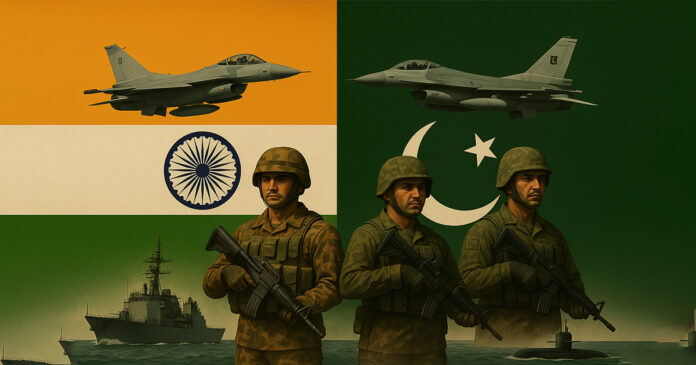The India-Pakistan rivalry has been around for more than seven decades, rooted deeply in history, politics, and war. The very core of this strained relationship is a constant military power comparison. Although both nations have developed extensively in terms of defence strength, one question persists: who is actually leading on land, air, and sea?
Land Forces
India boasts one of the world’s biggest and strongest armies with more than 1.4 million active personnel and another 1.2 million in reserve. Pakistan, while smaller in size with some 650,000 active soldiers, is famous for its battle-hardened and well-trained military.
In hardware, India has more than 4,700 tanks, both the locally manufactured Arjun MBT and Russian-made T-90 and T-72 types. Pakistan’s arsenal is estimated at about 2,400 tanks, like the Al-Khalid and the Chinese Type-85. India also maintains a greater inventory of artillery and superior air defence systems, such as the recently purchased Russian S-400.
Yet Pakistan’s ground forces possess experience in counter-insurgency and urban combat, developed over decades of operation in tribal regions and border districts, providing it with a tactical advantage in unconventional warfare.
Read More: India-Pakistan Tensions Reach a Boiling Point: What’s Actually at Stake?
Air Power
Air dominance is an important aspect of contemporary warfare, and in this India has a quantitative and qualitative advantage. The Indian Air Force (IAF) operates more than 2,000 aircraft, and of these approximately 600 are combat aircraft. The principal assets are the French Rafale, Russian Su-30MKI, Mirage-2000, and the home-built Tejas fighter aircraft.
Pakistan’s Air Force, while smaller with roughly 1,400 aircraft and around 350 combat jets, is extremely agile. Its F-16s remain a key deterrent, supplemented by the China-Pakistan co-developed JF-17 Thunder and the newly inducted J-10C fighter jets from China.
India’s strategic advantage is in its better logistics, surveillance UAVs, and in-flight refuelling capabilities, which enable longer-range missions. Nevertheless, Pakistani pilots and tactical concepts have proved to be effective, particularly in the 2019 Balakot incident.
Naval Power
This is where India has a crucial edge. The Indian Navy has an aircraft carrier (INS Vikramaditya), nuclear-powered submarines (such as INS Arihant), and a strong fleet of destroyers, frigates, and corvettes. The overall fleet consists of more than 150 ships.
Pakistan’s Navy, relatively small, has about 50 ships with no aircraft carrier. It has, however, a submarine fleet and is extending its outreach with Chinese assistance, such as modern Type-054A frigates and Hangor-class submarines due around 2028.
Conclusion
While India has an advantage in the size of its military, Pakistan’s strategic focus, rapid modernisation, and highly trained forces make it a worthy opponent. In any war scenario, the human, political, and international implications would vastly exceed the raw numbers—making diplomacy the most potent instrument of all.
Stay tuned to Brandsynario for latest news and updates





































